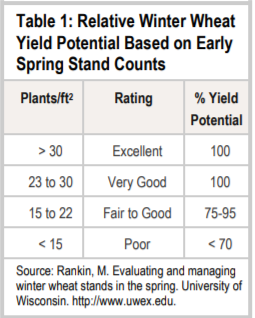
Apr 10, 2023, 8:00 AM
Evaluating Winter Wheat Survival
Spring has finally shown up for most of our area and now is the time to start evaluating winter wheat stands for winter kill. One of the main things that help winter wheat survival throughout the winter is having well established growth before freezing in the fall. Ideally you want a well-established crown with a couple tillers.
Much like the procedure used for evaluating alfalfa stands after winter, many of the same principles apply to winter wheat as well. It is best to get out in the field as soon as the ground temperatures start to warm up, when winter wheat will start to break dormancy. This takes a consistent soil temperature of 39 degrees.
TEST FOR WINTERKILL
To test for winterkill damage, you will need to dig up a few crowns and inspect the color of the crowns and roots. Remember color is not a sure indicator of wheat survival. If the crown and roots are a nice white color, the plant is still alive. If the crown and roots are brownish in color, odds are the plant is dead. Place the plants in a bucket and apply water. If the plants quickly green up, it is likely they do not have winterkill. If the plants don’t respond, the field may have suffered winterkill.
You can also do what is called a bag test. Retrieve winter wheat seedlings from the field, place in a closed plastic bag and leave them in a warm room for 24-48 hours. If the crown has a brownish or dry appearance, then you should be concerned. Crown tissue that is severely damaged will quickly turn brown, but health tissue will remain white.
DETERMINE PLANT POPULATION
 Growers will need to determine their plant populations by doing stand counts. To complete a stand count, observe three feet of row in at least five random locations throughout the field. To find the stand count, count the number of plants in the three-foot long area and find the average of the different counts. Then take that average multiply the number by four, then divide by the row width, in inches. This will determine the number of plants per square foot.
Growers will need to determine their plant populations by doing stand counts. To complete a stand count, observe three feet of row in at least five random locations throughout the field. To find the stand count, count the number of plants in the three-foot long area and find the average of the different counts. Then take that average multiply the number by four, then divide by the row width, in inches. This will determine the number of plants per square foot.
Acceptable final stand will depend on where you are located. Ideally, this number should range between 23 and 30 plants per square foot. However, winter wheat has the ability to fill in gaps so anything from 15 to 22 plants per square foot can potentially rebound and reach maximum yield potential.
EVALUATE NUMBER OF TILLERS
If the head count per plant is higher than average, stand issues can be overcome. A high number of tillers per area can compensate for lack of stand. Tillers are the ancillary stems that branch out from the main stem. Some varieties will not tiller profusely so it is wise to understand how different varieties can compensate.
To determine the number of tillers, repeat the same process used to determine plant population, this time count both the tillers and the main stems. As a rule of thumb, more than 60 tillers per square foot is necessary for a viable crop.
MAKING A DECISION
Once you have followed the three steps above, you will need to make a decision on the field. If winterkill has damaged small isolated area or a relatively small percentage of the overall field, it is recommended that the field be left. Remember that certain areas like hilltops often show the most damage but are quite often a small percentage of the whole field.
If winterkill is uniform across the field, it would be advisable to top-dress the field with nitrogen to promote or enhance tillering. This nitrogen application should occur as soon as the plant breaks dormancy for maximum effect.
Remember that these open areas are now susceptible to weed pressure. Consider making an additional herbicide application to control early-emerging summer weeds like kochia, pigweed and Russian thistle.
If large areas are affected the best option may be to abandon the crop and replant to another crop. Before making this decision, get advice from your local agronomist. Your agronomist should be able to help you understand any herbicide carryover or rotational restrictions that may affect a replanted crop. Also prior to removing a crop, contact your crop insurance company to determine your options.

